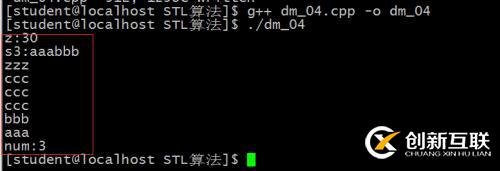find_if(),plus,for_each()的用法-創(chuàng)新互聯(lián)
1、STL算法--find_if()

(1)、代碼如下:
#include<iostream>
#include<vector>
#include<algorithm>
#include<functional>
using namespace std;
template<typename Type>
class IsDiv{
public:
IsDiv(const Type &divisor){
this->divisor = divisor;
}
bool operator()(Type &t){
return t%divisor == 0;
}
protected:
private:
Type divisor;
};
int main(void){
vector<int> v2;
for(int i = 10; i < 33; i++){
v2.push_back(i);
}
int a = 4;
IsDiv<int> myDiv(a);
//find_if(v2.begin(), v2.end(), myDiv);
vector<int>::iterator it;
it =find_if(v2.begin(), v2.end(), IsDiv<int>(a) );
if(it == v2.end()){
cout<<"容器中沒有值是4的元素"<<endl;
}else{
cout<<"第一個(gè)被4整除的元素是:"<<*it<<endl;
}
return 0;
}(2)、運(yùn)行結(jié)果:

2、STL算法--plus的使用
(1)、代碼如下:
#include<iostream>
#include<vector>
#include<algorithm>
#include<functional>
using namespace std;
//plus 預(yù)定義好的函數(shù)對(duì)象,能實(shí)現(xiàn)不同數(shù)據(jù) + 算法;
//實(shí)現(xiàn)了數(shù)據(jù)類型和算法的分離======》通過函數(shù)對(duì)象技術(shù)實(shí)現(xiàn)的;
//
//思考,怎么知道plus<type>是2個(gè)參數(shù)------>多看看源碼;
void main21(){
plus<int> intAdd;
int x = 10;
int y = 20;
int z = intAdd(x, y);
cout<<"z:"<<z<<endl;
plus<string> stringAdd;
string s1 = "aaa";
string s2 = "bbb";
string s3 = stringAdd(s1, s2);
cout<<"s3:"<<s3<<endl;
vector<string> v1;
v1.push_back("bbb");
v1.push_back("aaa");
v1.push_back("ccc");
v1.push_back("zzz");
v1.push_back("ccc");
v1.push_back("ccc");
sort(v1.begin(), v1.end(), greater<string>()); //降序排列;
vector<string>::iterator it;
for(it = v1.begin(); it != v1.end(); it++){
cout<<*it<<endl;
}
//求“ccc”出現(xiàn)的字符串的個(gè)數(shù);
string sc = "ccc"; //函數(shù)適配器:將函數(shù)和參數(shù)強(qiáng)行綁定;
//equal_to<string>有2個(gè)參數(shù),left參數(shù)來自容器,right參數(shù)來自sc,
//bind2nd就是函數(shù)適配器:把預(yù)定義函數(shù)對(duì)象和第二個(gè)參數(shù)進(jìn)行綁定;`
int num = count_if(v1.begin(), v1.end(), bind2nd(equal_to<string>(), sc));
cout<<"num:"<<num<<endl;
}
int main(void){
main21();
return 0;
}(2)、運(yùn)行結(jié)果:

3、STL算法--for_each()
(1)、代碼如下:
#include<iostream>
#include<vector>
#include<algorithm>
#include<functional>
using namespace std;
void printV(vector<int> &v){
vector<int>::iterator it;
for(it = v.begin(); it != v.end(); it++){
cout<<*it<<" ";
}
cout<<endl;
}
void showElem(int &n){
cout<<n<<" ";
}
class MyShow{
public:
MyShow(){
num = 0;
}
void operator()(int &n){
num++;
cout<<n<<" ";
}
void printNum(){
cout<<"num :"<<num<<endl;
}
private:
int num;
};
int main(void){
vector<int> v1;
v1.push_back(1);
v1.push_back(3);
v1.push_back(5);
printV(v1);
//第三個(gè)參數(shù)是:函數(shù)對(duì)象/回掉函數(shù)
//for_each(v1.begin(), v1.end(), showElem); //利用的是回調(diào)函數(shù)
for_each(v1.begin(), v1.end(), MyShow()); //利用的是函數(shù)對(duì)象(這個(gè)類中重載了())
//函數(shù)的返回值是函數(shù)對(duì)象
cout<<endl;
MyShow my1 = for_each(v1.begin(), v1.end(), MyShow()); //利用的是函數(shù)對(duì)象(這個(gè)類中重載了())
my1.printNum();
return 0;
}(2)、運(yùn)行結(jié)果:

4、for_each()和transform()的區(qū)別
(1)、代碼如下:
#include<iostream>
#include<vector>
#include<algorithm>
#include<functional>
using namespace std;
void showElem(int &n){
cout<<n<<" ";
}
int showElem2(int &n){
cout<<n<<" ";
return n;
}
//for_each和transform的本質(zhì)區(qū)別:
//結(jié)論:
//1、一般情況下,for_each所使用的函數(shù)對(duì)象,參數(shù)是引用,沒有返回值;
//2、transform所使用的函數(shù)對(duì)象,參數(shù)一般不使用引用,而是還有返回值;
int main(void){
vector<int> v1;
v1.push_back(1);
v1.push_back(3);
v1.push_back(5);
vector<int> v2 = v1;
for_each(v1.begin(), v1.end(), showElem);
transform(v2.begin(), v2.end(), v2.begin(), showElem2);//transform對(duì)回調(diào)函數(shù)的要求;返回值必須有
cout<<endl;
return 0;
}運(yùn)行結(jié)果:

另外有需要云服務(wù)器可以了解下創(chuàng)新互聯(lián)scvps.cn,海內(nèi)外云服務(wù)器15元起步,三天無理由+7*72小時(shí)售后在線,公司持有idc許可證,提供“云服務(wù)器、裸金屬服務(wù)器、高防服務(wù)器、香港服務(wù)器、美國服務(wù)器、虛擬主機(jī)、免備案服務(wù)器”等云主機(jī)租用服務(wù)以及企業(yè)上云的綜合解決方案,具有“安全穩(wěn)定、簡(jiǎn)單易用、服務(wù)可用性高、性價(jià)比高”等特點(diǎn)與優(yōu)勢(shì),專為企業(yè)上云打造定制,能夠滿足用戶豐富、多元化的應(yīng)用場(chǎng)景需求。
本文題目:find_if(),plus,for_each()的用法-創(chuàng)新互聯(lián)
鏈接分享:http://chinadenli.net/article34/eccse.html
成都網(wǎng)站建設(shè)公司_創(chuàng)新互聯(lián),為您提供網(wǎng)站改版、虛擬主機(jī)、手機(jī)網(wǎng)站建設(shè)、網(wǎng)站建設(shè)、移動(dòng)網(wǎng)站建設(shè)、Google
聲明:本網(wǎng)站發(fā)布的內(nèi)容(圖片、視頻和文字)以用戶投稿、用戶轉(zhuǎn)載內(nèi)容為主,如果涉及侵權(quán)請(qǐng)盡快告知,我們將會(huì)在第一時(shí)間刪除。文章觀點(diǎn)不代表本網(wǎng)站立場(chǎng),如需處理請(qǐng)聯(lián)系客服。電話:028-86922220;郵箱:631063699@qq.com。內(nèi)容未經(jīng)允許不得轉(zhuǎn)載,或轉(zhuǎn)載時(shí)需注明來源: 創(chuàng)新互聯(lián)
猜你還喜歡下面的內(nèi)容
- Go語言中如何通過Lua腳本操作Redis-創(chuàng)新互聯(lián)
- ae的alpha遮罩在哪里AE怎樣添加遮罩?-創(chuàng)新互聯(lián)
- tensorflow實(shí)現(xiàn)圖像的裁剪和填充方法-創(chuàng)新互聯(lián)
- DVWA系列之18CSRF漏洞分析-創(chuàng)新互聯(lián)
- Android應(yīng)用程序簽名-創(chuàng)新互聯(lián)
- 小程序中vidao實(shí)現(xiàn)視頻播放和彈幕功能的示例分析-創(chuàng)新互聯(lián)
- 43的愛情數(shù)字含義“43”有什么特殊的含義?-創(chuàng)新互聯(lián)

- 自適應(yīng)網(wǎng)站建設(shè)該如何去設(shè)置 2013-06-07
- 自適應(yīng)網(wǎng)站制作時(shí)有哪些方面需要注意呢 2021-09-08
- 成都建站介紹自適應(yīng)網(wǎng)站有哪些優(yōu)缺點(diǎn)? 2016-10-26
- 深度刨析自適應(yīng)網(wǎng)站設(shè)計(jì)的特點(diǎn) 2021-04-29
- 如何判斷響應(yīng)式網(wǎng)站和自適應(yīng)網(wǎng)站 2016-10-07
- 自適應(yīng)網(wǎng)站有哪些優(yōu)勢(shì)特點(diǎn) 2021-09-17
- 自適應(yīng)網(wǎng)站建設(shè)的三個(gè)規(guī)范要求 2016-08-22
- 自適應(yīng)網(wǎng)站如何做好優(yōu)化? 2022-12-25
- H5自適應(yīng)網(wǎng)站建設(shè)要注意哪些方面 2020-12-04
- 解讀自適應(yīng)網(wǎng)站有哪些優(yōu)缺點(diǎn) 2021-12-09
- 自適應(yīng)網(wǎng)站建設(shè)方案 2021-05-15
- 網(wǎng)站建造與自適應(yīng)網(wǎng)站建設(shè) 2023-03-24